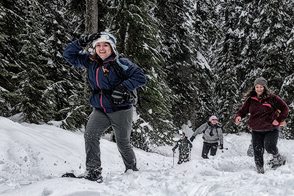Antonio Solorio helps national park tap into L.A.’s Latinx majority
The Santa Monica Mountains National Recreation Area is a 157,000-acre quilt of national park, California state park and state beach lands, bordered by the Pacific Ocean and inland valleys. It’s located in the greater Los Angeles region, and during a recent three-day visit to the park, I saw more people of color on trails than I’d seen during most of my life. It was surprising, even shocking, given the National Park Service’s ongoing struggle with diversity. Some 80 percent of park visitors are white; units with high numbers of non-white visitors are extremely rare.
NPS Workforce Diversity
This story is part of a package about diversity in the National Parks workforce. Also see:
 Nancy Fernandez: NPS pipeline backup.
Nancy Fernandez: NPS pipeline backup.
 Masyih Ford: A changed system failure.
Masyih Ford: A changed system failure.
Santa Monica’s diverse visitors mostly come from neighboring Los Angeles and Oxnard Counties, where half the population is Latinx. Its programs annually serve 14,000 students from Title I schools, with high concentrations of low-income families, in Los Angeles. The park’s staffing is also diverse – another rarity in an agency whose workforce is 83 percent white. Vanessa Torres, a Latina, oversees the park’s innovative mobile visitor center, La Ranger Troca, and Michael Liang, who is gay and Chinese American, manages the unit’s messaging and is a “centennial ambassador” for the agency at large. But perhaps no one embodies the park’s intentions and successes more than Antonio Solorio. Born in Tijuana, he grew up in East Los Angeles, which has the highest concentration of Latinx in the city – nearly 97 percent. It also is a neighborhood characterized as “park poor,” whose largest open green spaces during Solorio’s childhood were cemeteries. The message, he says, was clear: “You have to die before you get to go and enjoy nature.”
In high school, a crush and his best friend, David Martinez, coaxed Solorio to the school’s Environmental Club, which also offered free lunches and field trips to the Santa Monica and San Gabriel Mountains. Solorio and Martinez got hooked on the outdoors, ending up doing trail work in a Student Conservation Association program at Yosemite National Park. His mother was worried that he was giving up a decent job at the corner liquor store and risking his well-being to “sleep with the bears,” but Solorio went anyway – and was transformed.
“Something started bubbling up,” Solorio says. “I started thinking about my mom and pops, my siblings, my friends in the neighborhood – how come they don’t get to see these beautiful things as well. When I got back home, I started seeing what was going down in my neighborhood – broken glass on playgrounds, broken homes, businesses that were broke, families that were broken – then juxtaposing that against all this awesome beauty I just witnessed.”
It’s often said that persistence, the ability to hang in there for as long as it takes, is essential if you want to work in the National Park Service. Solorio was determined enough to take on seven years of seasonal work and internships at various national parks and national forests, while attending Cal State Los Angeles and grad school at Cal State Northridge, hustling two or three jobs at a time to make ends meet. He eventually landed at his present post, leading the Santa Monica (SAMO) Youth Program, which seeks to inspire diverse high-school students to support and steward public lands.
SAMO Youth has had its share of success placing alumni at Santa Monica and 16 other national park units, but its biggest contribution may be redefining what park leaders consider to be successful outcomes of recruitment efforts. Job openings in the agency are scarce, especially for entry-level positions. So Solorio focuses on the public allies SAMO Youth has produced, as well as the legions of those steered into outdoors or public-lands careers, including those outside the National Park Service. The agency still benefits because new advocates are created in areas where demographics are changing quickly, and public support cannot be taken for granted.
Santa Monica Mountains may be on to something: If the National Park Service is mostly powerless to improve workforce diversity, because it doesn’t have jobs to offer and has strict limitations on its hiring process, perhaps it needs to completely re-write the story. In other words, it could start measuring the success of its current programs and efforts not by job placements, but by relationships forged, amplifying those relationships to produce younger and more diverse stakeholders, even if they are outside the agency.
“We see a bigger picture – act locally, but think globally,” Solorio says. “It’s the ripple effects that count.”
NOTE: This story was part of our winning entry in Outstanding Beat Reporting from the Society of Environmental Journalists



